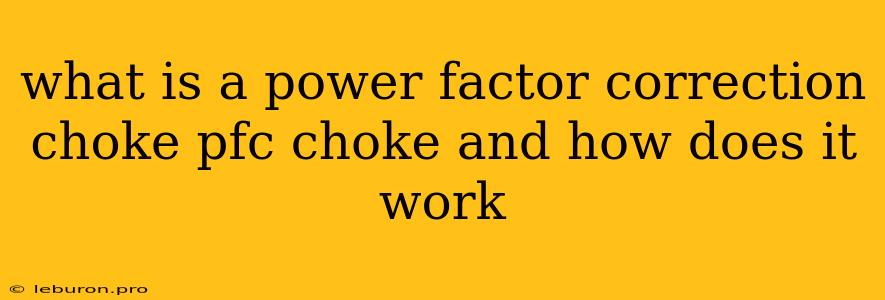Power factor correction (PFC) is a crucial aspect of electrical systems, particularly in applications where minimizing energy loss and maximizing efficiency are paramount. A key component in achieving this is the power factor correction choke, commonly known as a PFC choke. This article delves into the concept of power factor correction, explores the workings of a PFC choke, and elucidates its significance in various electrical systems.
Understanding Power Factor Correction
Power factor is a measure of how effectively electrical power is being utilized in a circuit. It is defined as the ratio of real power (measured in watts) to apparent power (measured in volt-amperes). An ideal power factor is 1, indicating that all the apparent power is being used for useful work. However, in practical circuits, this is rarely the case.
In circuits with inductive loads, such as motors, transformers, and fluorescent lights, the current lags behind the voltage. This phase difference between voltage and current leads to a power factor less than 1, implying that only a portion of the apparent power is actually doing work.
Impact of Low Power Factor
A low power factor can have several adverse consequences:
- Increased energy losses: A lower power factor means that a greater amount of current is flowing through the circuit to deliver the same amount of real power. This increased current causes higher resistive losses in the wiring and other components, leading to wasted energy.
- Higher operating costs: The increased energy losses due to a low power factor translate to higher electricity bills.
- Oversized equipment: To handle the increased current, electrical equipment, such as transformers and generators, must be oversized, leading to higher initial costs.
- Voltage drops: The increased current can cause significant voltage drops in the distribution system, affecting the performance of sensitive equipment.
The Role of PFC Chokes
Power factor correction chokes play a vital role in improving the power factor of an electrical system. These are inductors specifically designed to introduce a leading current that counteracts the lagging current caused by inductive loads.
How PFC Chokes Work
A PFC choke consists of a coil of wire wound around a magnetic core. When an alternating current flows through the coil, it creates a magnetic field. This magnetic field opposes any change in the current flowing through the coil, effectively delaying the current. By introducing this delay, the PFC choke shifts the current waveform closer in phase with the voltage waveform, thereby improving the power factor.
Types of PFC Chokes
PFC chokes can be classified into different types based on their construction and operating characteristics:
- Passive PFC Chokes: These are the most common type, typically consisting of a simple coil of wire wound around a ferromagnetic core. They are generally inexpensive and reliable but have limitations in terms of their ability to correct power factor.
- Active PFC Chokes: These employ active electronic circuits to dynamically control the inductance of the choke, providing a more precise and efficient power factor correction. Active PFC chokes are more complex and expensive than passive chokes but offer superior performance.
- Hybrid PFC Chokes: These combine the features of both passive and active PFC chokes, offering a balance of cost-effectiveness and performance.
Benefits of PFC Chokes
Implementing PFC chokes in electrical systems offers numerous advantages:
- Reduced energy losses: By improving the power factor, PFC chokes minimize the current flowing through the circuit, reducing resistive losses and energy waste.
- Lower electricity bills: Reduced energy losses translate to lower electricity consumption and consequently, lower energy bills.
- Improved system efficiency: A higher power factor improves the overall efficiency of the electrical system, leading to better utilization of electrical power.
- Enhanced equipment performance: The reduced current and voltage drops improve the performance of electrical equipment, extending their lifespan and reducing maintenance costs.
- Reduced equipment size: By minimizing the current, PFC chokes allow for the use of smaller and less expensive electrical equipment, leading to cost savings.
- Compliance with regulations: Many jurisdictions have regulations requiring industries to maintain a certain power factor. PFC chokes help industries comply with these regulations, avoiding potential fines and penalties.
Applications of PFC Chokes
Power factor correction chokes are widely used in various electrical systems to improve efficiency and performance. Some common applications include:
- Industrial applications: Motors, transformers, welding equipment, and other heavy-duty industrial machinery often benefit from the use of PFC chokes.
- Commercial applications: Lighting systems, air conditioning units, and other commercial appliances can benefit from PFC chokes to reduce energy consumption.
- Residential applications: Although less common in residential settings, PFC chokes can be employed in appliances like refrigerators and washing machines to improve energy efficiency.
Choosing the Right PFC Choke
Selecting the appropriate PFC choke requires considering factors such as:
- Load type: The type of load (inductive, capacitive, or mixed) determines the required inductance of the choke.
- Load size: The size of the load (measured in kVA or kW) determines the required rating of the choke.
- Operating voltage: The voltage of the system dictates the voltage rating of the choke.
- Frequency: The frequency of the power supply determines the appropriate operating frequency of the choke.
Conclusion
Power factor correction chokes play a crucial role in improving the efficiency and performance of electrical systems. By correcting the phase difference between voltage and current, PFC chokes minimize energy losses, reduce operating costs, and enhance equipment performance. Their applications extend across industrial, commercial, and residential settings, making them essential components in ensuring a reliable and efficient electrical infrastructure. Understanding the workings and benefits of PFC chokes empowers individuals and organizations to optimize their power systems for enhanced energy efficiency and cost savings.
